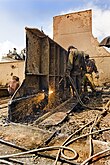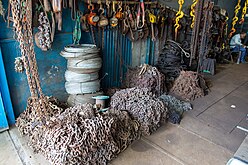Ship breaking
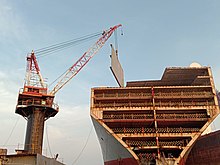
Ship breaking (also known as ship recycling, ship demolition, ship scrapping, ship dismantling, or ship cracking) is a type of ship disposal involving the breaking up of ships either as a source of parts, which can be sold for re-use, or for the extraction of raw materials, chiefly scrap. Modern ships have a lifespan of 25 to 30 years before corrosion, metal fatigue and a lack of parts render them uneconomical to operate.[2] Ship-breaking allows the materials from the ship, especially steel, to be recycled and made into new products. This lowers the demand for mined iron ore and reduces energy use in the steelmaking process. Fixtures and other equipment on board the vessels can also be reused. While ship-breaking is sustainable, there are concerns about its use by poorer countries without stringent environmental legislation. It is also labour-intensive, and considered one of the world's most dangerous industries.[3]
In 2012, roughly 1,250 ocean ships were broken down, and their average age was 26 years.[4][5] In 2013, the world total of demolished ships amounted to 29,052,000 tonnes, 92% of which were demolished in Asia. As of January 2020, Alang Ship Breaking Yard in India has the largest global share at 30%,[6] followed by Chittagong Ship Breaking Yard in Bangladesh and Gadani Ship Breaking Yard in Pakistan.[7]
The largest sources of ships are China, Greece, and Germany, although there is greater variation in the sources of carriers versus their disposal.[8] The ship-breaking yards of India, Bangladesh, China and Pakistan employ 225,000 workers as well as providing many indirect jobs. In Bangladesh, the recycled steel covers 20% of the country's needs and in India it is almost 10%.[9]
As an alternative to ship breaking, ships may be sunk to create artificial reefs after legally mandated removal of hazardous materials (though this does not recycle any materials), or sunk in deep ocean waters. Storage is a viable temporary option, whether on land or afloat, though most ships will eventually be scrapped; some will be sunk, or preserved as museums.
History
[edit]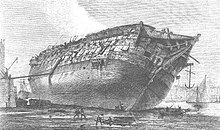
Wooden-hulled ships were simply set on fire or "conveniently sunk". In Tudor times (1485–1603), ships were dismantled and the timber re-used. This procedure was no longer applicable with the advent of metal-hulled boats[10] in the 19th century.
In 1880 Denny Brothers of Dumbarton used forgings made from scrap maritime steel in their shipbuilding. Many other nations began to purchase British ships for scrap by the late 19th century, including Germany, Italy, the Netherlands and Japan. The Italian industry started in 1892, and the Japanese industry after the passing of an 1896 law to subsidise native shipbuilding.[10]
After suffering damage or disaster, liner operators did not want the name of a broken ship to tarnish the brand of their passenger services. Many Victorian ships made their final voyages with the final letter of their name chipped off.[10]
In the 1930s it became cheaper to "beach" a boat by running her ashore—as opposed to using a dry dock. The ship would have to weigh as little as possible and would run ashore at full speed. Dismantling operations required a 10-foot (3 m) rise of tide and close proximity to a steel-works. Electric shears, a wrecking ball and oxy-acetylene torches were used. The technique of the time closely resembles that used in developing countries as of 2020[update]. Thos. W. Ward Ltd., one of the largest breakers in the United Kingdom in the 1930s, would recondition and sell all furniture and machinery. Many historical artifacts were sold at public auctions: the Cunarder RMS Mauretania, sold as scrap for £78,000, received high bids for her fittings worldwide. However, any weapons and military information, even if obsolete, were carefully removed by Navy personnel before turning over the ship for scrapping.[10]
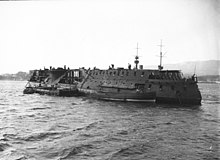
In 2020, as the COVID-19 pandemic crippled the cruise ship trade, cruise vessels began to appear more frequently in ship breaking facilities.[11]
Location trends
[edit]Until the late 20th century the majority of ship breaking activity took place in the port cities of industrialized countries such as the United Kingdom and the United States. As of 2020[update] those dismantlers that still remain in the United States work primarily on government-surplus vessels.[citation needed]
Starting in the mid-20th century, East Asian countries with lower labour costs began to dominate ship-breaking. As labour costs rose, centres of the ship-breaking industry moved—initially from countries such as Japan and Hong Kong, to Korea and Taiwan and then to China. For example, the southern port city of Kaohsiung in Taiwan operated as the world's leading dismantling site in the late 1960s and 1970s, breaking up 220 ships totaling 1.6 million tons in 1972 alone;[12] in 1977 Taiwan continued to dominate the industry with more than half the market share, followed by Spain and Pakistan. At the time, Bangladesh had no capacity at all. However, the sector is volatile and fluctuates wildly, and Taiwan processed just two ships 13 years later as wages across East Asia rose.[13][14] For comparison, depending on their profession, shipbreakers in Kaohsiung earned from NT$40 (day labourer) to NT$180 (torch operator) per day in 1973.[12]
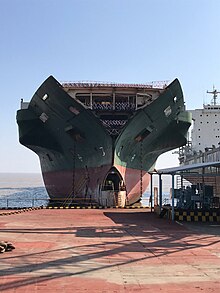
In 1960, after a severe cyclone, the Greek ship M D Alpine was stranded on the shores of Sitakunda, Chittagong (then part of East Pakistan). It could not be re-floated and so remained there for several years. In 1965 the Chittagong Steel House bought the ship and had it scrapped. It took years to scrap the vessel, but the work gave birth to the industry in Bangladesh. Until 1980 the Gadani Ship Breaking Yard of Pakistan was the largest ship breaking yard in the world.[citation needed]
Tightening environmental regulations resulted in increased hazardous waste disposal costs in industrialised countries in the 1980s, causing the export of retired ships to lower-income areas, chiefly in South Asia. This, in turn, created a far worse environmental problem, subsequently leading to the Basel Convention of 1989. In 2004 a Basel Convention decision officially classified old ships as "toxic waste", preventing them from leaving a country without the permission of the importing state.[15] This has led to a resurgence of recycling in environmentally compliant locations in developed countries, especially in former shipbuilding yards.[16]
On 31 December 2005 the French Navy's Clemenceau left Toulon to be dismantled at the Alang Ship Breaking Yard, India—despite protests over improper disposal capabilities and facilities for the toxic wastes. On 6 January 2006 the Supreme Court of India temporarily denied access to Alang,[17] and the French Conseil d'État ordered Clemenceau to return to French waters.[18] Able UK in Hartlepool received a new disassembly contract to use accepted practices in scrapping the ship.[19][20] The dismantling started on 18 November 2009 and the break-up was completed by the end of 2010; the event was considered a turning point in the treatment of redundant vessels.[19][failed verification] Europe and the United States have had a resurgence in ship scrapping since the 1990s.[citation needed]
In 2009 the Bangladesh Environmental Lawyers Association won a legal case prohibiting all substandard ship breaking. For 14 months the industry could not import ships and thousands of jobs were lost before the ban was annulled.[21][need quotation to verify] That same year, the global recession and lower demand for goods led to an increase in the supply of ships for decommissioning. The rate of scrapping is inversely correlated to the freight price, which collapsed in 2009.[22]
Technique
[edit]The decommissioning process is entirely different in developed countries than it is in third world countries. In both cases, ship-breakers bid for the ship, and the highest bidder wins the contract.[23] The ship-breaker then acquires the vessel from the international broker who deals in outdated ships.[24] The price paid is approximately $400 per tonne; regions with more lax environmental legislation typically can offer higher prices.[25][26] For the industry in Bangladesh, 69% of revenue is spent on purchasing vessels; only 2% is labour costs.[13] The ship is taken to the decommissioning location either under its own power or with the use of tugs.[14]
Developing countries
[edit]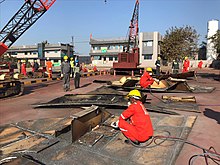
In developing countries, chiefly the Indian subcontinent, ships are run ashore on gently sloping sand tidal beaches at high tide so that they can be accessed for disassembly. In the beaching method, no external source of energy is used to pull the ship, as opposed to the dry dock method of ship recycling where a ship is floated into the dry dock using a substantial amount of energy.[27] However, maneuvering a large ship onto a beach at high speed takes skill and daring even for a specialist captain, and is not always successful.[28] Next, the anchor is dropped to steady the ship and the engine is shut down.[29] It takes 50 labourers about three months to break down a normal-sized cargo vessel of about 40,000 tonnes.[24]
Before the decommissioning begins, various clearances and permissions are obtained from regulatory, pollution and customs authorities after a thorough inspection is conducted by them. The ship recycling process then begins with the draining of fuel, hydraulic fluid, coolant, lubricating oils and firefighting liquid which may be disposed of or sold to the trade. Any reusable fixtures are sold to the trade. Any kind of waste such as plastic, garbage, or oily sand is sent to waste treatment facilities, like the Common Hazardous Waste Treatment Storage Disposal Facility (CHW-TSDF) set up by the Gujarat Maritime Board in Alang. Any usable oil is sent to government authorized refineries where used oil is chemically treated. The next steps entail recovering unused and partially spent materials, disposal of bilge water, recovering and obtaining reusable materials, and safe disposal of bio-hazardous materials like asbestos and glass wool. Each of these materials are inspected and sent to regulated waste treatment facilities or to buyers for further use and processing.[30]
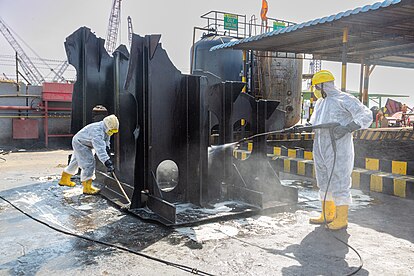
In recycling yards in the Indian subcontinent, specifically in Alang, upgraded facilities such as 100% impervious floors with drainage systems, heavy-lift cranes, yard and vessel-specific training for workers, and the development and implementation of Ship Recycling Facility Plans and Ship Recycling Plans (as per IMO's guidelines in Resolutions MEPC.210(63) and MEPC.196(62)) have been implemented.[31]
Developed countries
[edit]In developed countries the dismantling process mirrors the technical guidelines for the environmentally sound management of the full and partial dismantling of ships, published by the Basel Convention in 2003.[5] Recycling rates of 98% can be achieved in these facilities.[32]
Prior to dismantling, an inventory of dangerous substances is compiled. All hazardous materials and liquids, such as bilge water, are removed before disassembly. Holes are bored for ventilation and all flammable vapours are extracted.
Vessels are initially taken to a dry dock or a pier, although a dry dock is considered more environmentally friendly because all spillage is contained and can easily be cleaned up. Floating is, however, cheaper than a dry dock.[citation needed] Stormwater discharge facilities will stop an overflow of toxic liquid into the waterways. The carrier is then secured to ensure its stability.[5] Often the propeller is removed beforehand to allow the watercraft to be moved into shallower water.[citation needed]
Workers must completely strip the ship down to a bare hull, with objects cut free using saws, grinders, abrasive cutting wheels, hand-held shears, plasma, and gas torches.[citation needed] Anything of value, such as spare parts and electronic equipment is sold for re-use, although labour costs mean that low-value items are not economical to sell. The Basel Convention demands that all yards separate hazardous and non-hazardous waste and have appropriate storage units, and this must be done before the hull is cut up. Asbestos, found in the engine room, is isolated and stored in custom-made plastic wrapping prior to being placed in secure steel containers, which are then landfilled.[32]
Many hazardous wastes can be recycled into new products. Examples include lead-acid batteries or electronic circuit boards. Another commonly used treatment is cement-based solidification and stabilization. Cement kilns are used because they can treat a range of hazardous wastes by improving physical characteristics and decreasing the toxicity and transmission of contaminants. Hazardous waste may also be "destroyed" by incinerating it at a high temperature; flammable wastes can sometimes be burned as energy sources. Some hazardous waste types may be eliminated using pyrolysis in a high-temperature electrical arc, in inert conditions to avoid combustion. This treatment method may be preferable to high-temperature incineration in some circumstances such as in the destruction of concentrated organic waste types, including PCBs, pesticides, and other persistent organic pollutants. Dangerous chemicals can also be permanently stored in landfills as long as leaching is prevented.[33][34]
Valuable metals, such as copper or aluminum in electric cable, that are mixed with other materials may be recovered by the use of shredders and separators in the same fashion as e-waste recycling. The shredders cut the electronics into metallic and non-metallic pieces. Metals are extracted using magnetic separators, air flotation separator columns, shaker tables, or eddy currents. Plastic almost always contains regulated hazardous waste (e.g., asbestos, PCBs, hydrocarbons) and cannot be melted down.[citation needed]
Large objects, such as engine parts, are extracted and sold as they become accessible.[citation needed] The hull is cut into 300-tonne sections, starting with the upper deck and working slowly downwards. While oxy-acetylene gas torches are most commonly used, detonation charges can quickly remove large sections of the hull. These sections are transported to an electric arc furnace to be melted down into new ferrous products, though toxic paint must be stripped prior to heating.[19]
Historical techniques
[edit]At Kaohsiung in the late 1960s and '70s, ships to be scrapped were tied up at berths in Dah Jen and Dah Lin Pu, at the southern end of Kaohsiung Harbor.[35] There were a total of 24 breaking berths at Kaohsiung; each berth was rented by the scrapper from the Port Authority at a nominal rate of NT$7 per square foot per month, and up to 18,000 square feet (1,700 m2) could be rented surrounding a 300-foot-long (91 m) berth at a time. A typical 5,000-ton ship could be broken up in 25 to 30 days.[12]
The process began with "cleaning", a process in which subcontractors would come on board the ship to strip it of loose and flammable items, which were often resold in second-hand shops. After that, the cutting crews would start to dismantle the hull, stern first; large sections were cut off the ship and moved via cranes and rigging taken from previously scrapped ships. Because the scrapping at Kaohsiung was done at the docks, scrap metal was placed on trucks waiting to transport it to Kaohsiung's mills.[35]
Conventions and regulations
[edit]The Basel Convention
[edit]The Basel Convention on the Control of Trans-boundary Movements of Hazardous Wastes and Their Disposal of 1989 was the first convention to environmentally govern the ship breaking industry. It has been ratified by 187 countries, including India and Bangladesh. It controls the international movement of hazardous wastes and for their environmentally sound management mainly through consent for the shipment between the authorities of the country exporting the hazardous wastes with the authorities of the importing country.[36]
Though the Basel Convention has notably reduced illegal exports of hazardous wastes to countries that are unable to process and dispose of them in an environmentally sound manner, it has failed to define the minimum standards of recycling soundly. It also completely ignores important aspects such as workers' safety and falls short in overcoming bureaucratic barriers when it comes to communication between exporting and importing countries.[37] Furthermore, the decision to scrap a ship is often made in international waters, where the convention has no jurisdiction.
The "Ban Amendment" to the Basel Convention was adopted in March 1994, prohibiting the export of hazardous wastes from OECD countries to non-OECD countries. The Amendment would enter into force 90 days after it has been ratified by at least three-quarters of the 87 countries that were Parties to the Convention at the time it was adopted. Croatia deposited the 66th ratification in September 2019, and the Ban Amendment entered into force 25 years after adoption on December 5, 2019. However, the European Union had already enacted the Ban Amendment unilaterally through the European Waste Shipment Regulation, which incorporated the Basel Convention and the Ban Amendment into European Union law in February 1993, the European Union replaced its previous regulation with the Waste Shipment Regulation (EC) No 1013/2006 (the WSR), which also unilaterally implemented the Ban Amendment, prohibiting the export of hazardous wastes from European Union member states to any developing (i.e. non-OECD), countries and regulating their export to OECD countries through the Basel Convention's prior informed consent mechanism.
When the European Commission attempted to apply the WSR to end-of-life ships, it encountered numerous obstacles and evasion. This is because, in enforcing the Ban Amendment, the European Waste WSR considers it illegal to recycle any ship that has started its last voyage from a European Union port in Bangladesh, China, India, or Pakistan, regardless of the flag the ship flies. These four non-OECD countries have consistently recycled around 95% of the world's tonnage. In fact, according to a study conducted by the European Commission in 2011, at least 91% of ships covered by the WSR disobeyed or circumvented its requirements. The European Commission admitted publicly that enforcing its own Waste Shipment Regulation to recycle ships had not been successful. The commission, unable to wait for the HKC to take effect, began developing new legislation to regulate the recycling of European-flagged ships. This led the European Commission in 2012 to propose the development of a new European Regulation on Ship Recycling.[37]
The Hong Kong Convention
[edit]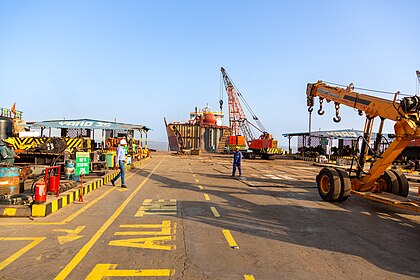
To overcome the difficulties of the Basel Convention in terms of the inordinate time and effort required in gaining the consent of all countries involved in its due time, and to highlight regulations that this convention left out, its governing body requested the International Maritime Organisation for a newer convention in 2004. Thus, the Hong Kong Convention came into existence.[37] In essence, the Convention aims to ensure that ships, when being recycled after reaching the end of their operational lives, do not pose any unnecessary risks to human health, safety and the environment.[38] The convention covers regulations including:
- the design, construction, operation and preparation of ships to facilitate safe and environmentally sound recycling, without compromising the safety and operational efficiency of ships;
- the operation of ship recycling facilities in a safe and environmentally sound manner; and
- the establishment of an appropriate enforcement mechanism for ship recycling (certification/reporting requirements).[39]
With much more sound standards of ship recycling, easier implementation and better supervision, the Hong Kong Convention was finally adopted in 2009.[25] However, the convention will only come into universal force 24 months after the date on which the following conditions are met:
- ratification or accession by 15 States,
- the fleet of the States that have ratified or acceded to represent at least 40 percent of world merchant shipping by gross tonnage, and
- the combined maximum annual ship recycling volume of the States during the preceding 10 years to constitute not less than 3 percent of the gross tonnage of the combined merchant shipping of the same States.[37]
As of 2 April 2023, 20 countries have acceded to the HKC, making up 30.16% of the world's merchant shipping by gross tonnage,[40] with a combined maximum annual ship recycling volume of the States at 2.6% of the gross tonnage of the combined merchant shipping of the same States. This leaves the second and third conditions yet to be fulfilled for the HKC to enter into force.[39]
Nearly 96 of India's 120 operational ship recycling yards have achieved Statements of Compliance (SoC) with the Hong Kong Convention by various IACS class societies—including ClassNK, IRClass, Lloyd's Register and RINA. In addition, a yard in Chattogram, Bangladesh has also become the first one to achieve an SoC by ClassNK in January 2020, having first achieved a RINA SoC in 2017. Furthermore, to encourage the growth of India's vital ship recycling sector, in November 2019, the Government of India acceded to the Hong Kong Convention for Safe and Environmentally Sound Recycling of Ships and became the only South Asian country and major ship recycling destination so far to take such a step.
The EU Ship Recycling Regulation
[edit]The work on the EU's Ship Recycling Regulation (SRR) was started in 2013, after the adoption of the requirements from the Hong Kong International Convention for the safe and environmentally sound recycling of ships (HKC). However, it differs from the HKC in the way yards are authorised and in its list of inventories of hazardous materials, or IHM [37] The argument for developing a specified regulation for ship recycling in the European Union, was the fact that the EU noticed how many EU ships that ended up in unsustainable recycling facilities. Europeans own around 40% of the world fleet, around 15000 ships. Among these around 10000 fly an EU Member-State flag, but only 7% of the EU-flagged ships are dismantled in the EU territory, and the rest are mostly dismantled in South Asia [41]
After the financial crisis in the early 2010s many ship owners ended up with an unexpected overcapacity of ships, and was selling of their vessels. The phasing out of single hull oil tankers, also provided a rush to change out ones fleet. The EUs new FuelEU maritime initiative is also incentivising decarbonization of the maritime sector, which requires ships to sail on new reenables or less polluting fuels[42]. This implies that the EU fleet already has and will undergo major changes and renewals in the coming years, thus leading to many ships being outdated or phased out, many being concerned for the end-of-life handling of these older ships [43].
The SRR aims to address the environmental and health hazards associated with ship dismantling by setting high standards for EU-flagged vessels at the end of their operational lives. One of the key components developed by the EU is the European List of Approved Ship Recycling Facilities, identifying the approved ports for all EU flagged ships to be recycled. For a ship recycling yard to be included in the list, the facilities must comply with strict environmental and worker safety standards, reducing toxic waste release and promoting safe dismantling practices. Member States report to the Commission on which facilities in their territory that comply to the requirements, and thereby get included on the list. Shipyards outside the EU can also be included on the European List but must apply to the Commission with proof of the yard’s standards [44].
To be included on the European List, ship recycling facilities must adhere to specific requirements set by the EU and aligned with the Hong Kong Convention and other international guidelines. Facilities need authorization, robust structural and operational standards, environmental safety protocols, and measures for monitoring health and safety risks to workers and nearby populations. This includes handling hazardous materials on impermeable surfaces, training workers and provide them with protective equipment, implementing emergency plans, and recording incidents. Operators must also submit recycling plans and completion reports, ensuring full compliance and minimizing environmental and health impacts during ship recycling activities. As of November 2024, it contains of 45 shipyards. Because the list works as a guarantee for an yards safety and validity, shipyards can both be removed and added to the list if they seize to comply to the regulation [45] [46] [47].
Additionally, to the list of approved facilities, the SRR also mandates each ship to hold an Inventory of Hazardous Materials (IHM), listing hazardous substances used in each ship's construction. By hazardous material’ means any material or substance which is liable to create hazards to human health and/or the environment. New installation of material such as asbestos and ozone-depleting substances are prohibited, and the occurrence of materials containing lead, mercury and radioactive substances, to name a few, are to be reported and restricted. This inventory, which must be maintained throughout the ship's life, helps guide shipyards and recyclers on safe waste management and reduces accidental environmental contamination. The ships also report on the operationally generated waste, meaning wastewater and residues generated by the normal operation of ships. By EU standards, any EU ship going for dismantling, all new European ships, and third-country ships stopping in EU ports need to have an inventory of hazardous materials on board [45] [46] [47]
This list, as of 27 July 2023, contains 48 ship-recycling facilities, including 38 yards in Europe (EU, Norway and UK), 9 yards in Türkiye and 1 yard in the USA. Several yards on the European List are also capable of recycling large vessels [48]. The list excluded some of the most major ship recycling yards in India and Bangladesh, which have achieved SoCs with the HKC in various class societies.[37] This exclusion has led to many ship owners changing the flag of their vessel before recycling or sell the ship to cash buyers, to evade the regulations [49] [50]. Excluded countries strive towards bringing the HKC into force as the universal regulation, arguing that it would be irrational if international shipping were regulated by multiple and competing standards.[37]
Dangers
[edit]Health risks
[edit]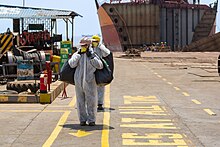
Seventy percent of ships are simply run ashore in developing countries for disassembly, where (particularly in older vessels) potentially toxic materials such as asbestos, lead, polychlorinated biphenyls and heavy metals along with lax industrial safety standards pose a danger for the workers. Burns from explosions and fire, suffocation, mutilation from falling metal, cancer and disease from toxins are regular occurrences in the industry. Asbestos was used heavily in ship construction until it was finally banned in most of the developed world in the mid-1980s. Currently, the costs associated with removing asbestos, along with the potentially expensive insurance and health risks, have meant that ship breaking in most developed countries is no longer economically viable. Dangerous vapours and fumes from burning materials can be inhaled, and dusty asbestos-laden areas are commonplace.[51]
Removing the metal for scrap can potentially cost more than the value of the scrap metal itself. In the developing world, however, shipyards can operate without the risk of personal injury lawsuits or workers' health claims, meaning many of these shipyards may operate with high health risks. Protective equipment is sometimes absent or inadequate. The sandy beaches cannot sufficiently support the heavy equipment, which is thus prone to collapse. Many are injured from explosions when flammable gas is not removed from fuel tanks. In Bangladesh, a local watchdog group claims that, on average, one worker dies per week and one is injured per day.[52][53]
The problem is caused by negligence from national governments, shipyard operators and former ship owners disregarding the Basel Convention.[53] According to the Institute for Global Labour and Human Rights, workers who attempt to unionize are fired and then blacklisted. The employees have no formal contract or any rights, and sleep in over-crowded hostels.[54] The authorities produce no comprehensive injury statistics, so the problem is underestimated.[53] Child labour is also widespread: 20% of Bangladesh's ship breaking workforce are below 15 years of age, mainly involved in cutting with gas torches.[4][55]
There is, however, an active ship-breaker's union in Mumbai, India (Mumbai Port Trust Dock and General Employees' Union) since 2003 with 15,000 members, which strikes to ensure fatality compensation.[56] It has set up a sister branch in Alang, gaining paid holidays and safety equipment for workers since 2005. They hope to expand all along the South Asian coastline.[14]
Even poor occupational safety record at Alang, the world's largest ship recycling destination, underlines the risks of the ship breaking industry. Poor worker safety has led to a number of accidents and dozens of workers deaths at the Alang yards over the years. According the IndustriALL Global Union affiliate, Alang Sosiya Ship Recycling and General Workers' Association (ASSRGWA), between January 2009 and October 2012, at least 54 workers had died in work-related accidents at the Alang shipbreaking yards.[57] Besides worker unions, such frequent accidents due to poor safety standards at Alang have also attracted EU scrutiny.[58]
In Alang, safety awareness drives with hoardings, posters, films as well as training programmes for different categories of workers under the Safety Training and Labour Welfare Institute,[59] safety evaluation by external teams, personal protective equipment (PPEs) including gloves, gumboot, goggles and masks are provided to workers to mitigate the hazards of their work. In addition to this, GMB has also included regular medical examinations of workers exposed to bio-hazardous materials,[30] provision of medical facilities at the Red Cross Hospital in Alang, mobile medical vans and health awareness programmes.[27]
Several United Nations committees are increasing their coverage of ship-breakers' human rights. In 2006, the International Maritime Organisation developed legally binding global legislation which concerns vessel design, vessel recycling and the enforcement of regulation thereof and a 'Green Passport' scheme. Water-craft must have an inventory of hazardous material before they are scrapped, and the facilities must meet health & safety requirements.[60][61] The International Labour Organization created a voluntary set of guidelines for occupational safety in 2003. Nevertheless, Greenpeace found that even pre-existing mandatory regulation has had little noticeable effect for labourers, due to government corruption, yard owner secrecy and a lack of interest from countries who prioritise economic growth. There are also guards who look out for any reporters.[62] To safeguard worker health, the report recommends that developed countries create a fund to support their families, certify carriers as 'gas-free' (i.e. safe for cutting) and to remove toxic materials in appropriate facilities before export.[53] To supplement the international treaties, organisations such as the NGO Shipbreaking Platform, the Institute for Global Labour and Human Rights and ToxicsWatch Alliance are lobbying for improvements in the industry.[63][64]
Environmental risks
[edit]In recent years, ship breaking has become an issue of environmental concern beyond the health of the yard workers. Many ship breaking yards operate in developing nations with lax or no environmental law, enabling large quantities of highly toxic materials to escape into the general environment and causing serious health problems among ship-breakers, the local population and wildlife.[65][66] Environmental campaign groups such as Greenpeace have made the issue a high priority for their activities.[67]
Along the Indian subcontinent, ecologically important mangrove forests, a valuable source of protection from tropical storms and monsoons, have been cut down to provide space for water-craft disassembly.[4] In Bangladesh, for example, 40,000 mangrove trees were illegally chopped down in 2009. The World Bank has found that the country's beaching locations are now at risk from sea level rise.[13] Twenty-one fish and crustacean species have been wiped out in the country as a result of the industry as well.[68] Lead, organotins such as tributyltin in anti-fouling paints, polychlorinated organic compounds, by-products of combustion such as polycyclic aromatic hydrocarbons, dioxins and furans are found in ships and pose a great danger to the environment.[4]
The Basel Convention on the Control of Trans-boundary Movements of Hazardous Wastes and Their Disposal of 1989 has been ratified by 166 countries, including India and Bangladesh, and in 2004, End of Life Ships were subjected to its regulations. It aims to stop the transportation of dangerous substances to less-developed countries and mandate the use of regulated facilities. Furthermore, the decision to scrap a ship is often made in international waters, where the convention has no jurisdiction.
The Hong Kong Convention is a compromise. It allows ships to be exported for recycling, as long as various stipulations are met: All water-craft must have an inventory and every shipyard needs to publish a recycling plan to protect the environment. The Hong Kong Convention was adopted in 2009 but with few countries signing the agreement.[25]
However, nearly 96 of the 120 ship recycling yards in India have achieved Statements of Compliance (SoC) with the Hong Kong Convention by various IACS class societies—including ClassNK, IRClass, Lloyd's Register and RINA. In addition, a yard in Chattogram, Bangladesh has also become the first one to achieve an SoC by ClassNK in January 2020, having first achieved a RINA SoC in 2017. Furthermore, to encourage the growth of India's vital ship recycling sector, in November 2019 the Government of India acceded to the Hong Kong Convention for Safe and Environmentally Sound Recycling of Ships and became the only South Asian country and major ship recycling destination so far to take such a positive step.[69]
In March 2012 the European Commission proposed tougher regulations to ensure all parties take responsibility. Under these rules, if a vessel has a European flag, it must be disposed of in a shipyard on an EU "green list". The facilities would have to show that they are compliant, and it would be regulated internationally in order to bypass corrupt local authorities. However, there is evidence of ship owners changing the flag to evade the regulations.[70] China's scrap industry has vehemently protested against the proposed European regulations. Although Chinese recycling businesses are less damaging than their South Asian counterparts, European and American ship-breakers comply with far more stringent legislation.[25]
That being said, ship recycling yard owners have made investments into upgrading their recycling facilities and safety infrastructure in the recent past, including 100% impervious floors with drainage systems,[69] setting up of hazardous waste processing facilities like the Common Hazardous Wastes Treatment, Storage and Disposal Facility (CHW-TSDF) in Alang,[27] and adherence to various internationally recognised conventions. The ship recycling industry also produces about 4.5 million tons of re-rollable steel per year.[69] That comes up to nearly 2% of total steel produced in India, coming from a process that does not exploit natural resources and thereby saves non-renewable natural resources and energy.[71] Recycling of one ton of scrap saves 1.1 tons of iron ore, 0.6–0.7 tons of coking coal and around 0.2–0.3 tons of fluxes. Specific energy consumption for production of steel through BF-BOF (primary) and EAF& IF (secondary routes) is 14 MJ/kg and 11.7 MJ/kg, respectively. Thus, it leads to savings in energy by 16–17%. It also reduces the water consumption and GHG emission by 40% and 58%, respectively.[72]
List of ship-breaking yards
[edit]The following are some of the world's largest ship breaking yards:[23]
Bangladesh
[edit]Belgium
[edit]China
[edit]India
[edit]
As of January 2020, India has a 30% share of ship breaking. Once India passes the planned "Recycling of Ships Act, 2019" which ratifies the Hong Kong International Convention for the safe and environmentally sound recycling of ships, ships not coming for breaking to India from the treaty nations of USA, Europe and Japan could also begin arriving in India, with the potential to double its global share of ship breaking to 60%. If that happens, it would also double India's annual ship breaking revenue to US$2.2 billion.[6]
Pakistan
[edit]Turkey
[edit]United Kingdom
[edit]United States
[edit]- SA Recycling, Brownsville, Texas
- International Shipbreaking, Brownsville, Texas
- Mare Island Dry Docks, Vallejo, California
Notable ship breaking yards
[edit]This is a list of notable ship breaking yards:
| Ship breaking yard | Country | City | Province | Founded | Plots | L (km) | ref |
|---|---|---|---|---|---|---|---|
| Chittagong Ship Breaking Yard | Bangladesh | Chittagong | Chittagong | 1960 | 18 | ||
| Alang Ship Breaking Yard | India | Alang | Gujarat | 1983 | 153 | ||
| Gadani Ship Breaking Yard | Pakistan | Balochistan | Gadani | 1947 | 132 | 10 | |
| Aliaga Ship Breaking Yard | Turkey | Aliağa | Izmir | 1976 | 28 | [74][75] | |
| Able UK at Graythorpe Dock | United Kingdom | Teesside | Teesside | ||||
| Galloo, Ghent, formerly Van Heyghen Recycling | Belgium | ||||||
| SA Recycling, Brownsville, Texas | United States | ||||||
| International Shipbreaking, Brownsville, Texas | United States | ||||||
| Mare Island Dry Docks, Vallejo, California | United States | ||||||
| Changjiang Ship Breaking Yard | China | Jiangyin |
Gallery
[edit]-
Safe accesses to the ships during recycling[76]
-
Ground view of Hong Kong Convention compliant ship recycling yard in Alang, india
-
Ship recycling in Alang
-
Jafrabad Chittagong ship breaking
-
Cutter-man in ship recycling yard
-
Jafrabad Chittagong ship breaking
-
Cleaning of oil-stained sections at Hong Kong Convention-compliant ship recycling yard in Alang, India
-
Impermeable floor in ship recycling yard[77]
-
Slicing of recycled vessel's hull using gas cutter in Hong Kong Convention compliant yard in India
-
Window cut for ventilation and illumination[78] during ship recycling
-
Sustainable Ship and Offshore Recycling Program team conducting safety inspections as part of safe recycling of offshore assets in Hong Kong Convention complaint yards in India
-
Jafrabad Chittagong ship breaking
-
Jafrabad Chittagong ship breaking
-
Jafrabad Chittagong ship breaking
-
Beached end-of-the-life vessel cut in zig-zag for stability[78] during ship recycling
-
Jafrabad Chittagong ship breaking
-
Safe removal of Hazardous material in Ship Recycling yard in India
-
Window cut for ventilation and illumination of hull[78] during ship recycling
-
Jafrabad Chittagong ship breaking
-
Jafrabad Chittagong ship breaking
-
Chittagong Ship Breaking Yard
-
Ship-breaking in Sitakunda
-
Shipbreaking Yard Bhatiari, Sitakunda
-
Fire fighting mock drill at ship recycling yard in Alang, India
-
Dhaka shipyard on Buriganga River
-
Safe access to beached vessel[78] in Alang
-
Chittagong Ship Breaking Yard
-
Indian second-hand shop selling used spare parts recovered during ship recycling
See also
[edit]- Bo'ness
- Clemenceau disposal controversy
- Flotsam, jetsam, lagan and derelict
- Marine debris
- Marine pollution
- Shipbreakers (film), by the National Film Board of Canada
- Ship decommissioning
- Ship Breaker, a young-adult novel by Paolo Bacigalupi
- Scrap
- Wrecking (shipwreck)
- List of dry docks
- List of the largest shipbuilding companies
- List of shipbuilders and shipyards
- Hardspace: Shipbreaker, a video game based on the ship breaking profession set in space
- Israel Shipyards
References
[edit]- ^ "Safe Accesses to the ships at HKC compliant Ship Recycling Facilities". GMS Leadership.
- ^ "Life Cycle of a Ship". shippipedia.com. 21 January 2011. Archived from the original on 24 March 2019. Retrieved 2 August 2015.
- ^ Lord, Ross; Logan, Nick (12 September 2013). "Ship breaking: Newfoundland's legacy with one of the most hazardous jobs". globalnews.ca. Shaw Media Inc. Retrieved 4 August 2015.
- ^ a b c d "NGO Shipbreaking Platform » Problems and Solutions". www.shipbreakingplatform.org. NGO Shipbreaking Platform. Archived from the original on 9 November 2015. Retrieved 2 August 2015.
- ^ a b c "Technical guidelines for the environmentally sound management of the full and partial dismantling of ships" (PDF). Basel Convention Series/SBC. ISSN 1020-8364. Retrieved 3 August 2015.
- ^ a b India eyes 60 per cent share of global ship recycling business; higher GDP contribution, Economic Times, 30 December 2019.
- ^ Miroux, Anne (20 November 2014). "Review of Maritime Transport 2014" (PDF). unctad.org. United Nations Conference on trade and development. Retrieved 2 August 2015.
- ^ Ashkar, Hisham H. (4 June 2015). "Shipbreaking in 2014". GRID-Arendal.
- ^ Rekacewicz, Philippe (25 February 2012). "Shipbreaking in Asia | GRID-Arendal – Maps & Graphics library". www.grida.no. GRID-Arendal. Archived from the original on 6 September 2015. Retrieved 2 August 2015.
- ^ a b c d Bowen, Frank C (10 November 1936). "The Shipbreaking Industry". Shipping Wonders of the World. www.naval-history.net. Retrieved 3 August 2015. alternate URL
- ^
Frishberg, Hannah (12 October 2020). "Luxury cruise ships being scrapped for metal amid ongoing pandemic". New York Post. NYP Holdings, Inc. Retrieved 23 October 2020.
As the cruise ship industry continues to be battered by the ongoing coronavirus pandemic, boats once considered to be opulent, top-of-the-line vessels are now being sold for scraps.
- ^ a b c "Shipbreaker to the world". Taiwan Review. 1 March 1973. Retrieved 9 December 2019.
- ^ a b c Sarraf, Maria (December 2010). "SHIP BREAKING AND RECYCLING INDUSTRY IN BANGLADESH AND PAKISTAN" (PDF). siteresources.worldbank.org. International Bank for Reconstruction and Development / World Bank. Retrieved 3 August 2015.
- ^ a b c Rane, Prathamesh V. (17 July 2014). "Echoes of Ship Breaking". www.youtube.com. Vega Productions. Retrieved 4 August 2015.
- ^ Heberlein, Claudia (November 2006). "Vital Waste Graphics 2" (PDF). www.grida.no. The Basel Convention Secretariat. p. 31. Archived from the original (PDF) on 4 March 2016. Retrieved 1 August 2015.
- ^ "AMERICAN SHIP BREAKING IT ALL COMES APART AT THE BOTTOM OF AMERICA". www.clui.org. The Center for Land Use Interpretation. Spring 2010. Retrieved 3 August 2015.
- ^ Zubair Ahmed (6 January 2006). "Stay out, India tells toxic ship". BBC News. Retrieved 5 March 2009.
- ^ "Chirac orders 'toxic' ship home". BBC News. 16 January 2006. Retrieved 5 March 2009.
- ^ a b c "Praise for 'toxic' ship scrapping". BBC News Online. 4 January 2010.
The dismantling of the former Clemenceau is a positive and pioneering operation in Europe
- ^ "Ghost ship arrives in north-east". BBC News. 8 February 2009. Retrieved 5 March 2009.
- ^ "Ship breaking in Bangladesh: Hard to break up". The Economist. 27 October 2012. ISSN 0013-0613. Retrieved 3 August 2015.
- ^ Ravichandran, K. (September 2012). "Ship Breaking Industry: Key Trends and Credit Implications" (PDF). www.moneycontrol.com. ICRA Limited, An Associate of Moody's Investors Service. Retrieved 3 August 2015.
- ^ a b Chanev, Chavdar (31 July 2015). "Ship Breaking". www.shipcruise.org. Ship Cruise. Retrieved 3 August 2015.
- ^ a b Gwin, Peter (May 2014). "The Ship-Breakers". ngm.nationalgeographic.com. National Geographic Society. Archived from the original on 10 March 2018. Retrieved 3 August 2015.
- ^ a b c d Hülsen, Isabell; Wagner, Wieland; Zand, Bernhard (14 February 2013). "Booming Scrap Business: Ship-Breaking Lessons from the Exxon Valdez". Spiegel Online. Retrieved 3 August 2015.
- ^ "The Graveyard of Giants: A history of ship breaking in Bangladesh". recyclingships.blogspot.co.uk. Unofficial Networks LLC. 28 February 2012. Retrieved 4 August 2015.
- ^ a b c Hiremath, Anand M.; Pandey, Sachin Kumar; Kumar, Dinesh; Asolekar, Shyam R. (1 January 2014). "Ecological Engineering, Industrial Ecology and Eco-Industrial Networking Aspects of Ship Recycling Sector in India". APCBEE Procedia. 5th International Conference on Environmental Science and Development – ICESD 2014. 10: 159–163. doi:10.1016/j.apcbee.2014.10.035. ISSN 2212-6708.
- ^ "On the Thames", 1 February 2014 http://onthethames.net/2014/02/01/video-shows-dramatic-beaching-pride-calais/
- ^ Dasgupta, Soumyajit (1 May 2013). "How Ship Dismantling is Done?". www.marineinsight.com. MarineInsight. Retrieved 3 August 2015.
- ^ a b Hiremath, Anand M.; Tilwankar, Atit K.; Asolekar, Shyam R. (15 January 2015). "Significant steps in ship recycling vis-a-vis wastes generated in a cluster of yards in Alang: a case study". Journal of Cleaner Production. 87: 520–532. Bibcode:2015JCPro..87..520H. doi:10.1016/j.jclepro.2014.09.031. ISSN 0959-6526.
- ^ "Where we stand today and Which standard to follow? | GMS Leadership". www.gmsinc.net. Retrieved 15 October 2021.
- ^ a b c "Able UK's TERRC yard on Teesside". BBC. 23 November 2010. Retrieved 3 August 2015.
- ^ "FedCenter – Hazardous Waste Landfills". Archived from the original on 14 May 2019. Retrieved 3 August 2015.
- ^ "Land Disposal Units". US EPA. Archived from the original on 15 March 2012.
- ^ a b Shaw, Jim (1 March 2018). "Getting Rid of Old Ships – The World of Shipbreaking". Pacific Maritime Magazine. Retrieved 9 December 2019.
- ^ "The Ship Recycling Regulations: Where we stand today and Which standard to follow?".
- ^ a b c d e f g "The Ship Recycling Regulations: Where we stand today and Which standard to follow?".
- ^ "Recycling of ships". International Maritime Organization. 2019.
- ^ a b "5 things to know about Hong Kong Convention for the Safe and Environmentally Sound Recycling of Ships, 2009".
- ^ "Portugal accedes to ship recycling convention". International Maritime Organization. 30 March 2023.
- ^ https://ec.europa.eu/environment/pdf/waste/ships/ENV-18-018_MEP_identifiers_final_web.pdf
- ^ "FuelEU maritime initiative: Council adopts new law to decarbonise the maritime sector".
- ^ "Single-hull oil tankers banned from European ports from 21 October 2003". European Commission - European Commission. Retrieved 23 December 2024.
- ^ "Ship Recycling: Updated list of European facilities includes three new yards - European Commission". environment.ec.europa.eu. Retrieved 23 December 2024.
- ^ a b Engels, Urs Daniel (2013). "European Ship Recycling Regulation". Hamburg Studies on Maritime Affairs. 24. doi:10.1007/978-3-642-35597-4. ISBN 978-3-642-35596-7. ISSN 1614-2462.
- ^ a b Regulation (EU) No 1257/2013 of the European Parliament and of the Council of 20 November 2013 on ship recycling and amending Regulation (EC) No 1013/2006 and Directive 2009/16/EC Text with EEA relevance, 20 November 2013, retrieved 23 December 2024
- ^ a b "Ships - European Commission". environment.ec.europa.eu. 6 December 2023. Retrieved 23 December 2024.
- ^ "Ship Recycling: Updated list of European facilities includes three new yards - European Commission". environment.ec.europa.eu. Retrieved 29 December 2024.
- ^ "Convenient shipbreaking: shortcomings of environmental obligations for EU ship owners and possible solutions – The NCLOS Blog". Retrieved 29 December 2024.
- ^ https://www.elni.org/fileadmin/elni/dokumente/Archiv/2012/Heft_2/elni2012-2_AC-Ormond_2_.pdf
- ^ "가비아 호스팅 서비스:웹호스팅,웹메일호스팅,쇼핑몰호스팅,단독서버,동영상호스팅". errdoc.gabia.io.
- ^ Vidal, John (5 May 2012). Bangladeshi workers risk lives in shipbreaking yards. The Guardian. Retrieved 16 March 2014.
- ^ a b c d Schuiling, Jacqueline (December 2005). "END OF LIFE SHIPS THE HUMAN COST OF BREAKING SHIPS" (PDF). www.shipbreakingplatform.org. Greenpeace International & FIDH IN COOPERATION WITH YPSA. Retrieved 3 August 2015.[permanent dead link]
- ^ Where Ships and Workers Go to Die. Institute for Global Labour and Human Rights via YouTube. Retrieved 21 August 2018.
- ^ Belhassen, Souhayr (June 2008). "Child Labour in the Ship Recycling Industry in Bangladesh Childbreaking Yards" (PDF). www.shipbreakingplatform.org. International Platform on Shipbreaking, FIDH, YSPA. Archived from the original (PDF) on 17 May 2017. Retrieved 3 August 2015.
- ^ Rane, Prathamesh (24 January 2013). "NGO Shipbreaking Platform » Video: The Wire Nest…life In Mumbai's Shipbreaking Yards". www.shipbreakingplatform.org. Vega Productions. Retrieved 3 August 2015.
- ^ "Again, workers are killed at shipbreaking yard in India". IndustriALL. 8 October 2012. Retrieved 2 January 2025.
- ^ admin_ec (10 September 2019). "Press Release - Two fatal accidents at Indian yards under EU scrutiny". NGO Shipbreaking Platform. Retrieved 2 January 2025.
- ^ "The unsaid truth of the ship recycling industry by BBC | GMS Leadership". www.gmsinc.net. Retrieved 15 October 2021.
- ^ Haugen, Eivind (13 March 2006). "Ship recycling: The IMO develops a new legally binding instrument". www.dnv.no. DNV Corporate Communications. Archived from the original on 23 September 2015. Retrieved 3 August 2015.
- ^ "Adopted on 1 December 2005 (Agenda item 11) NEW LEGALLY BINDING INSTRUMENT ON SHIP RECYCLING" (PDF). imo.org. INTERNATIONAL MARITIME ORGANIZATION. 6 February 2006. Archived from the original (PDF) on 24 September 2015. Retrieved 3 August 2015.
- ^ "May 2014". Magazine. Archived from the original on 10 March 2018. Retrieved 12 September 2019.
- ^ Murder in the Shipbreaking Yards. Institute for Global Labour and Human Rights, 2 December 2015.
- ^ "COMMENT OF TOXICSWATCH ALLIANCE (TWA) ON "CHANGES PROPOSED IN THE SHIP BREAKING CODE 2013 | ToxicsWatch, Journal of Earth, Science, Economy and Justice". www.toxicswatch.org.
- ^ "UK cruise ships scrapped in India's 'ship graveyard'". BBC News. 2 March 2021. Retrieved 11 August 2021.
- ^ Gioia, Rosalinda; Eckhardt, Sabine; Breivik, Knut; Jaward, Foday; Prieto, Ailette; Nizzeto, Luca; Jones, Kevin C. (January 2011). "Evidence for Major Emissions of PCBs in the West African Region". Environmental Science & Technology. 45 (4): 1349–1355. Bibcode:2011EnST...45.1349G. doi:10.1021/es1025239. PMID 21226526.
- ^ "End of Life: The Human Cost of Breaking Ships". Greenpeace. 12 December 2005. Retrieved 16 March 2014.
- ^ "NGO Shipbreaking Platform » Why ships are toxic". www.shipbreakingplatform.org. NGO Shipbreaking Platform. May 2014. Retrieved 3 August 2015.
- ^ a b c "Our response to BBC misrepresenting ship recycling in India | GMS Leadership". www.gmsinc.net. Retrieved 15 October 2021.
- ^ "Off the beach". www.offthebeach.org. NGO Shipbreaking Platform. 17 December 2012. Retrieved 3 August 2015.
- ^ Deshpande, Paritosh C.; Kalbar, Pradip P.; Tilwankar, Atit K.; Asolekar, Shyam R. (15 November 2013). "A novel approach to estimating resource consumption rates and emission factors for ship recycling yards in Alang, India". Journal of Cleaner Production. 59: 251–259. Bibcode:2013JCPro..59..251D. doi:10.1016/j.jclepro.2013.06.026. ISSN 0959-6526.
- ^ "Why the Beaching Method of Ship Recycling Should Not Be Criticized | Hellenic Shipping News Worldwide". www.hellenicshippingnews.com. Retrieved 15 October 2021.
- ^ Boonzaier, Johnothan (27 February 2013). "NGO Shipbreaking Platform » Tradewinds – Galloo Gent joins green-recycling body". www.shipbreakingplatform.org. NGO Shipbreaking Platform. Archived from the original on 26 July 2021. Retrieved 4 August 2015.
- ^ Neşer, Gökdeniz; Ünsalan, Deniz; Tekoğul, Nermin; Stuer-Lauridsen, Frank (1 February 2008). "The shipbreaking industry in Turkey: environmental, safety and health issues". Journal of Cleaner Production. 16 (3): 350–358. Bibcode:2008JCPro..16..350N. doi:10.1016/j.jclepro.2006.08.018. ISSN 0959-6526.
- ^ "Turkey". NGO Shipbreaking Platform. Retrieved 29 September 2023.
- ^ "Stability of vessel's hull during recycling | GMS Leadership". www.gmsinc.net. Retrieved 18 March 2021.
- ^ "GMS Leadership | World's Largest Buyer of Ships and Offshore Assets". www.gmsinc.net. Retrieved 18 March 2021.
- ^ a b c d "GMS Leadership | World's Largest Buyer of Ships and Offshore Assets". www.gmsinc.net. Retrieved 18 March 2021.
Intro Definition Chittagong ship breaking yard. Was worlds largest or a while Advantage Environmental- Reduction in Greenhouse Gas Emissions: Shipbreaking helps mitigate greenhouse gas emissions by recycling steel instead of producing it from raw materials. According to a study by the NGO Shipbreaking Platform, recycling one ton of steel saves approximately 1.5 tons of CO2 emissions compared to steel production from virgin materials. Economy- 1.2 billion us dollars from shipbreaking in 2020 Job creation- Employs 200,000 directly and 50,000 indirectly Disadvantages Environment-Pollution of Coastal Waters: Shipbreaking operations release a significant amount of pollutants into coastal waters, including heavy metals, oils, and toxic chemicals. It's estimated that around 120,000 metric tons of oil are released annually into the Bay of Bengal due to shipbreaking activities. Air Pollution: Burning of materials during shipbreaking emits hazardous pollutants into the air, including sulfur dioxide, nitrogen oxides, and particulate matter. This contributes to poor air quality in the surrounding areas. Studies have shown that shipbreaking activities in Bangladesh release approximately 800,000 tons of CO2 annually. •Unsafe conditions- The Bangladesh Institute of Labour Studies reported that only 10% of shipbreaking yards have access to emergency medical facilities on-site. As well as 10% proper safety. Toxic substance, sharp objects, over strenuous activities. Unfair- 12 hour days, 1-2. Shipbreaking laborers often find themselves denied breaks or sick leave, even in cases of on-the-job injuries, a clear violation of Bangladesh's labor regulations. Additionally, they frequently receive wages well below the legal minimum for shipbreaking work. Lack of formal contracts further enables yard owners to obscure incidents of worker harm. When workers seek to unionize or raise concerns, they face dismissal and intimidation tactics.
Solutions Safety sessions that are already happening credit to ypsa Remove beaching and employ drydocking
Further reading
[edit]- Langewiesche, William (2004). The Outlaw Sea: Chaos and Crime on the World's Oceans. London: Granta Books. ISBN 0-86547-581-4. Contains an extensive section on the shipbreaking industry in India and Bangladesh.
- Buxton, Ian L. (1992). Metal Industries: shipbreaking at Rosyth and Charlestown. World Ship Society. p. 104. OCLC 28508051. Ships scrapped include Mauretania and much of the German Fleet at Scapa Flow. Ships listed with owners and dates sold.
- Buerk, Roland (2006). Breaking Ships: How supertankers and cargo ships are dismantled on the shores of Bangladesh. Chamberlain brothers. p. 192. ISBN 1-59609-036-7. Breaking Ships follows the demise of the Asian Tiger, a ship destroyed at one of the twenty ship-breaking yards along the beaches of Chittagong. BBC Bangladesh correspondent Roland Buerk takes us through the process—from beaching the vessel to its final dissemination, from wealthy shipyard owners to poverty-stricken ship cutters, and from the economic benefits for Bangladesh to the pollution of its once pristine beaches and shorelines.
- Bailey, Paul J. (2000). "Is there a decent way to break up ships?". Sectoral Activities Programme. International Labour Organization. Retrieved 29 May 2007.
- Rousmaniere, Peter (2007). "Shipbreaking in the Developing World: Problems and Prospects". International Journal of Occupational and Environmental Health. 13 (4): 359–68. doi:10.1179/oeh.2007.13.4.359. PMID 18085049. S2CID 22198147. Archived from the original on 3 March 2012. Retrieved 15 May 2009. Analysis of the economics of shipbreaking, the status of worldwide reform efforts, and occupational health and safety of shipbreaking including results of interviewing Alang shipbreakers.
- Siddiquee, N.A. 2004. Impact of ship breaking on marine fish diversity of the Bay of Bengal.DFID SUFER Project, Dhaka, Bangladesh. 46 pp.
- Siddiquee, N. A., Parween, S., and Quddus, M. M. A., Barua, P., 2009 ‘Heavy Metal Pollution in sediments at ship breaking area of Bangladesh ‘Asian Journal of Water, Environment and Pollution, 6 (3) : 7–12
External links
[edit]| External videos | |
|---|---|
- NGO Platform on Shipbreaking
- OSHA Fact Sheet – Shipbreaking
- Regulatory information on Ship recycling[usurped]
- Bangladesh ship breaking photos
- The Ship-Breakers at National Geographic.
- The Ship-Breakers Archived 10 March 2018 at the Wayback Machine at National Geographic.
- Ship breaking by Drachinifel

![Safe accesses to the ships during recycling[76]](http://up.wiki.x.io/wikipedia/commons/thumb/c/c9/Safe_Accesses_to_the_ships_during_recycling.jpg/220px-Safe_Accesses_to_the_ships_during_recycling.jpg)
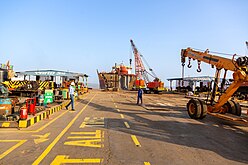
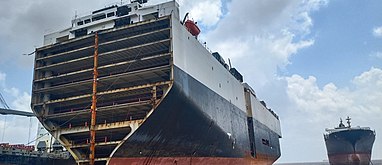
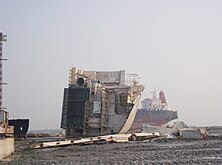
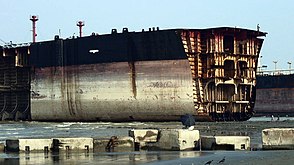
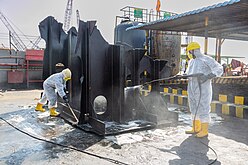
![Impermeable floor in ship recycling yard[77]](http://up.wiki.x.io/wikipedia/commons/thumb/8/88/Ship_recycling_yard_workers.jpg/220px-Ship_recycling_yard_workers.jpg)
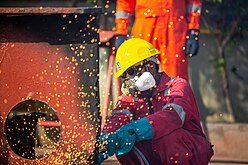
![Window cut for ventilation and illumination[78] during ship recycling](http://up.wiki.x.io/wikipedia/commons/thumb/8/8f/Window_cut_for_Ventilation_%26_illumination_of_hull_for_stability.png/381px-Window_cut_for_Ventilation_%26_illumination_of_hull_for_stability.png)
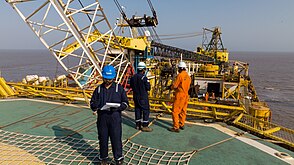
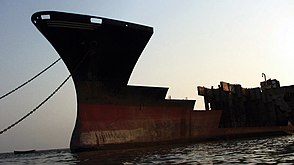
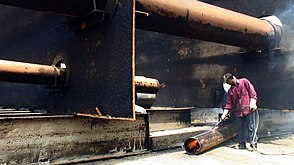
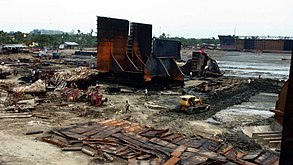
![Beached end-of-the-life vessel cut in zig-zag for stability[78] during ship recycling](http://up.wiki.x.io/wikipedia/commons/thumb/d/db/Beached_vessel_hull_cut_for_stability.png/384px-Beached_vessel_hull_cut_for_stability.png)
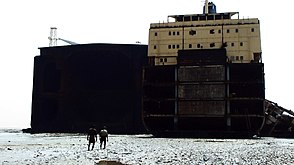
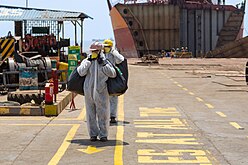
![Window cut for ventilation and illumination of hull[78] during ship recycling](http://up.wiki.x.io/wikipedia/commons/thumb/1/18/Window_cut_for_Ventilation_%26_illumination_of_hull_during_ship_recycling.png/297px-Window_cut_for_Ventilation_%26_illumination_of_hull_during_ship_recycling.png)
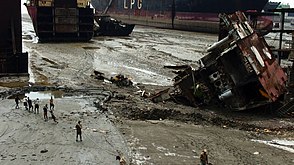
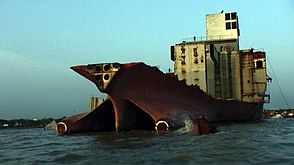

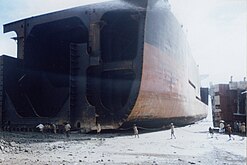
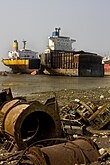
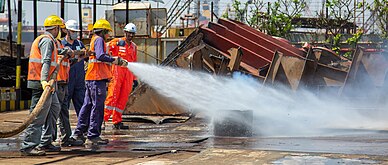
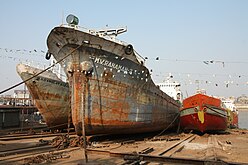
![Safe access to beached vessel[78] in Alang](http://up.wiki.x.io/wikipedia/commons/thumb/4/49/Safe_Accesses_to_the_beached_end_of_the_life_ships_for_recycling.jpg/124px-Safe_Accesses_to_the_beached_end_of_the_life_ships_for_recycling.jpg)
